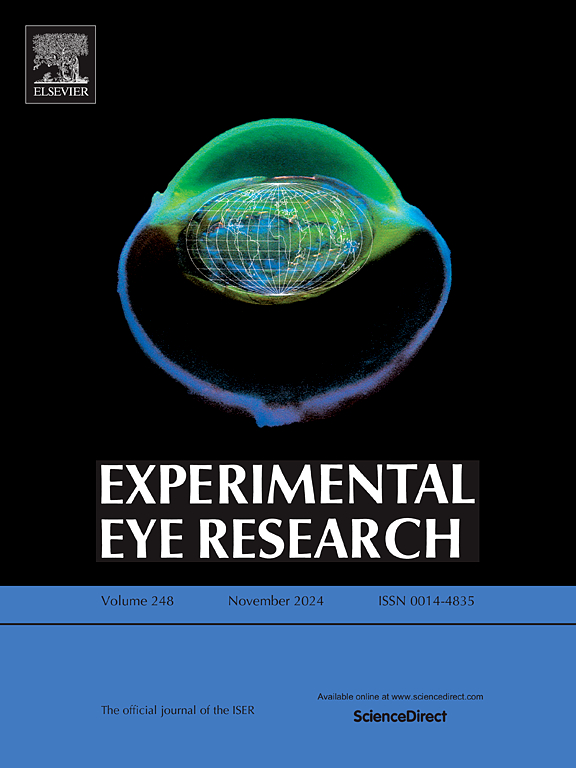Optical and retinal changes influenced by different lighting conditions
IF 3
2区 医学
Q1 OPHTHALMOLOGY
引用次数: 0
Abstract
Retinal morphology, specifically in its curvature, and ocular aberrations change when the eye adapts to different lighting conditions, including photopic, scotopic, mesopic, blue light, and red light. Sixty healthy young subjects with refractive error less than ±4.00 D of sphere and 3.00 D of cylinder, not suffering from accommodative problems, ocular or systemic pathology, and not having used electronic devices half an hour before or having taken substances that alter the retina during the 2 h prior to the study were included. The subjects adapted to five lighting conditions, each for 5 min, in a controlled environment. Ocular aberrometry and Optical Coherence Tomography (OCT) were taken to capture images of the central and peripheral retina before (baseline measurements) and after adaptation to each lighting condition. The OCT images were exported and processed to analyze retinal curvature, obtaining parameters such as eccentricity, asphericity and shape factor. The results showed that the shape of the retina was hyperbolic prolate, becoming flatter in scotopic and blue light conditions, and more curved in mesopic conditions. Retinal curvature was closest to baseline under red light and photopic conditions. Aberrometric differences, particularly in the C(2,0) polynomial for defocus, showed higher values in mesopic, baseline, and scotopic conditions, and lower values in photopic, blue light, and red light. Significant differences were also observed in spherical aberrations C(4,0) and C(6,0), vertical coma C(3,-1), and trefoil C(3,-3). The spherical equivalent indicated more myopic values in mesopic, baseline, and scotopic conditions, and more hyperopic values in blue, photopic, and red light, suggesting a link between myopia and lower luminosity. This study concludes that illumination affects retinal curvature and ocular refraction, influencing myopia.
受不同照明条件影响的光学和视网膜变化。
当眼睛适应不同的光照条件时,视网膜形态(特别是曲率)和眼像差都会发生变化,这些条件包括光照、散光、中光、蓝光和红光。研究对象包括 60 名健康的年轻受试者,他们的球面屈光不正小于 ±4.00D ,柱面屈光不正小于 3.00D,没有适应性问题、眼部或全身性疾病,在研究前半小时内没有使用过电子设备,也没有服用过改变视网膜的药物。受试者在受控环境中适应五种照明条件,每种条件持续 5 分钟。在适应每种照明条件之前(基线测量)和之后,受试者通过眼球像差仪和光学相干断层扫描(OCT)捕捉视网膜中央和周边的图像。输出并处理 OCT 图像以分析视网膜曲率,从而获得偏心率、非球面度和形状因子等参数。结果表明,视网膜的形状呈双曲线状,在散光和蓝光条件下变得扁平,而在中近视条件下则更加弯曲。在红光和光照条件下,视网膜曲率最接近基线。视差差异,尤其是散焦的 C(2,0) 多项式,在中视、基线和散光条件下显示较高值,而在光视、蓝光和红光条件下显示较低值。球面像差 C(4,0) 和 C(6,0)、垂直彗差 C(3,-1) 和三叶形像差 C(3,-3) 也有显著差异。球面等效度在中视、基线和散光条件下显示出更多的近视值,而在蓝光、光照和红光条件下显示出更多的远视值,这表明近视与低照度之间存在联系。研究得出结论,光照会影响视网膜曲率和眼屈光度,从而影响近视。
本文章由计算机程序翻译,如有差异,请以英文原文为准。
求助全文
约1分钟内获得全文
求助全文
来源期刊

Experimental eye research
医学-眼科学
CiteScore
6.80
自引率
5.90%
发文量
323
审稿时长
66 days
期刊介绍:
The primary goal of Experimental Eye Research is to publish original research papers on all aspects of experimental biology of the eye and ocular tissues that seek to define the mechanisms of normal function and/or disease. Studies of ocular tissues that encompass the disciplines of cell biology, developmental biology, genetics, molecular biology, physiology, biochemistry, biophysics, immunology or microbiology are most welcomed. Manuscripts that are purely clinical or in a surgical area of ophthalmology are not appropriate for submission to Experimental Eye Research and if received will be returned without review.
 求助内容:
求助内容: 应助结果提醒方式:
应助结果提醒方式:


